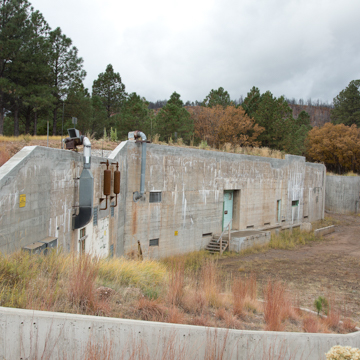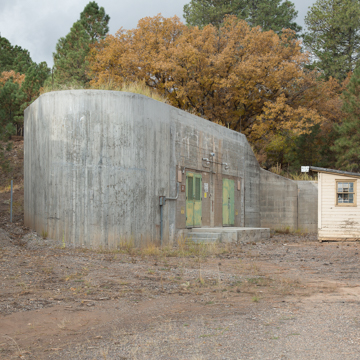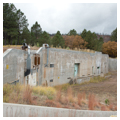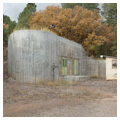You are here
Gun Site
Named after a former ranch, the Anchor West Site or Anchor Ranch Proving Ground in Technical Area 8 contains four structures known as the Gun Site. While the basic technology of military ordnance was well established, the cannon barrel of the gun-type atomic bomb required high-alloy tubes manufactured to precise specifications and consequently required testing. The site was in use by September 1943, though the first test guns did not arrive from the Naval Gun Factory until March 1944. The tests were documented with high-speed photography.
Three structures housed laboratories and shops. Constructed of board-formed, cast-in-place reinforced concrete, the buildings face north along one side of a ravine and back protectively against earth berms that also cover their roofs: this placed them safely below the level of the gun emplacements to the south. Except for lites in the entry doors, there are no exterior windows. A central laboratory and shop building (TA-8-1) abuts a second laboratory (TA-8-3) at an oblique angle to the east and stands across an access road to the west from a shop and storage building with a rounded or “boat-tail” corner (TA-8-2). TA-8-1 originally had a wooden observation tower, to the right of the concrete loading dock, from which the proving ground with its gun emplacements to the south could be monitored.
The fourth structure (TA-8-172) is a portable wooden guard shack of a type that was once common throughout Project Y. All four structures are included in the Manhattan National Historical Park.
References
Los Alamos National Laboratory. The History and Legacy of the Manhattan Project at Los Alamos National Laboratory. Los Alamos, NM: Los Alamos National Laboratory, 2015.
McGehee, Ellen, Sheila McCarthy, Ken Towery, John Ronquillo, Kari Garcia, and John Isaacson. Sentinels of the Atomic Dawn: A Multiple-Property Evaluation of the Remaining Manhattan Project Properties at Los Alamos (1942–1946). Historic Building Survey Report No. 215. Los Alamos: Los Alamos National Laboratory, 2003.
National Park Service. Manhattan Project Sites. Special Resource Study/Environmental Assessment. Washington, D.C.: Department of the Interior, 2010.
Writing Credits
If SAH Archipedia has been useful to you, please consider supporting it.
SAH Archipedia tells the story of the United States through its buildings, landscapes, and cities. This freely available resource empowers the public with authoritative knowledge that deepens their understanding and appreciation of the built environment. But the Society of Architectural Historians, which created SAH Archipedia with University of Virginia Press, needs your support to maintain the high-caliber research, writing, photography, cartography, editing, design, and programming that make SAH Archipedia a trusted online resource available to all who value the history of place, heritage tourism, and learning.

















